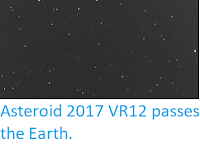Asteroid 2018 FE3 passed by the Earth at a distance of about 146 300
km (0.38 times the average distance between the Earth and the Moon, or
0.01% of the distance between the Earth and the Sun), slightly after 7.10 am
GMT on Monday 18 March 2018. There was no danger of
the asteroid hitting us, though were it to do so it would not have
presented a significant threat. 2018 FE3 has an estimated
equivalent
diameter of 7-23 m (i.e. it is estimated that a spherical object
with
the same volume would be 7-23 m in diameter), and an object of
this
size would be expected to explode in
an airburst (an explosion caused by superheating from friction with the
Earth's atmosphere, which is greater than that caused by simply
falling, due to the orbital momentum of the asteroid) in the atmosphere
between 37 and 20 km above the ground, with only fragmentary material
reaching the Earth's surface.
The calculated orbit of 2018 FE3. Minor Planet Center.
2018 FE3 was discovered on 21 March 2018 (three days after its closest approach to the Earth) by the University of Arizona's Catalina Sky Survey,
which is located in the Catalina Mountains north of Tucson. The
designation 2018 FE3 implies that it was the 80th asteroid (asteroid E3)
discovered in the second half of March 2018 (period 2018 F).
2018 FE3 has a 304 day orbital period, with an elliptical orbit tilted at
an angle of 6.91° to the plain of the Solar System which takes in to
0.70 AU from the Sun (70% of the distance at which the Earth orbits the
Sun, roughly the distance at which Venus orbits the Sun) and out to
1.07 AU (7%
further away from the Sun than the Earth). This means that close
encounters between the asteroid and Earth are fairly common, with the
last thought to have happened in September 2013 and the next predicted
in August this year. Although it does cross the Earth's
orbit and is briefly
further from the Sun on each cycle, 2018 FE3 spends most of its time
closer to the Sun than we are, and is therefore classified as an Aten
Group Asteroid. This also means that the asteroid has occasional close encounters with the planet Venus, with the last calculated to have occurred in March 2007, and the next predicted for March 2021.
See also...
Follow Sciency Thoughts on Facebook.







